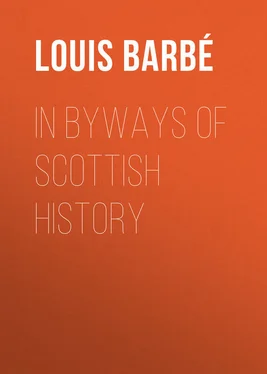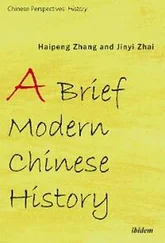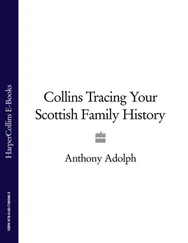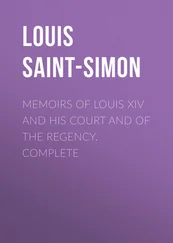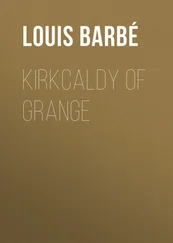Louis Barbé - In Byways of Scottish History
Здесь есть возможность читать онлайн «Louis Barbé - In Byways of Scottish History» — ознакомительный отрывок электронной книги совершенно бесплатно, а после прочтения отрывка купить полную версию. В некоторых случаях можно слушать аудио, скачать через торрент в формате fb2 и присутствует краткое содержание. Жанр: foreign_antique, foreign_prose, на английском языке. Описание произведения, (предисловие) а так же отзывы посетителей доступны на портале библиотеки ЛибКат.
- Название:In Byways of Scottish History
- Автор:
- Жанр:
- Год:неизвестен
- ISBN:нет данных
- Рейтинг книги:4 / 5. Голосов: 1
-
Избранное:Добавить в избранное
- Отзывы:
-
Ваша оценка:
- 80
- 1
- 2
- 3
- 4
- 5
In Byways of Scottish History: краткое содержание, описание и аннотация
Предлагаем к чтению аннотацию, описание, краткое содержание или предисловие (зависит от того, что написал сам автор книги «In Byways of Scottish History»). Если вы не нашли необходимую информацию о книге — напишите в комментариях, мы постараемся отыскать её.
In Byways of Scottish History — читать онлайн ознакомительный отрывок
Ниже представлен текст книги, разбитый по страницам. Система сохранения места последней прочитанной страницы, позволяет с удобством читать онлайн бесплатно книгу «In Byways of Scottish History», без необходимости каждый раз заново искать на чём Вы остановились. Поставьте закладку, и сможете в любой момент перейти на страницу, на которой закончили чтение.
Интервал:
Закладка:
In the month of May, 1566, Mary Beton married Alexander Ogilvie, of Boyne. But little is known of this marriage beyond the fact that the Queen named the day, and beyond such circumstances of a purely legal and technical nature as may be gathered from the marriage contract, which is still extant, and has been published in the Miscellany of the Maitland Club. It sets forth that the bride was to have a dowry from her father of 3000 merks, and a jointure from her husband of lands yielding 150 merks and 30 chalders of grain yearly. This legal document derives its chief interest from bringing together in a friendly transaction persons who played important and hostile parts in the most interesting period of Scottish history. It bears the signatures of the Queen and Henry Darnley, together with those of the Earls of Huntly, Argyll, Bothwell, Murray, and Atholl, as cautioners for the bridegroom, that of Alexander Ogilvie himself, who subscribes his territorial style of "Boyne" and that of "Marie Bethune". The signature of the bride's father, and that of Michael Balfour, of Burleigh, his cautioner for payment of his daughter's tocher, are wanting.
It would appear that Mary Beton, or, as she was usually called after her marriage, "the Lady Boyn", or "Madame de Boyn", did not immediately retire from the Court. In what capacity, however, she kept up her connection with it, cannot be ascertained. All that we have been able to discover is that after her marriage she received several gifts of ornaments and robes from the Queen. Amongst the latter we notice a dress which was scarcely calculated to suit the fair beauty: "Une robbe de satin jeaulne dore toute goffree faicte a manches longues toute chamaree de bisette d'argent bordee dung passement geaulne goffre d'argent!" 96
Both Mary Beton and Alexander Ogilvie are said to have been living as late as 1606. All that is known as to the date of her death is that it occurred before that of her husband, who, in his old age, married the divorced wife of Bothwell, the Countess Dowager of Sutherland.
It is interesting to note the contrast between the comparatively uneventful reality of Mary Beton's life and the romantic career assigned to her in one of the best-known works of fiction that introduces her in connection with her royal and ill-fated mistress. In Mr. Swinburne's Mary Stuart , the catastrophe is brought about by Mary Beton. For some score of years, from that day forth when she beheld the execution of him on whom she is supposed to have bestowed her unrequited love, of the chivalrous, impetuous Chastelard, when her eyes "beheld fall the most faithful head in all the world", Mary Beton, "dumb as death", has been waiting for the expiation, waiting
Even with long suffering eagerness of heart
And a most hungry patience.
It is by her action in forwarding to Elizabeth the letter in which Mary Stuart summed up all the charges brought against her rival, that the royal captive's doom is hastened, that Chastelard's death is avenged. It would be the height of hypercritical absurdity to find fault with the poet for the use which he has made of a character which can scarcely be called historical. Nevertheless, as it is often from fiction alone that we gather our knowledge of the minor characters of history – of those upon which more serious records, engrossed with the jealousies of crowned heads, with the intrigues of diplomatists and the wrangles of theologians, have no attention to bestow – it does not seem altogether useless at least to point out how little resemblance there is between the Mary Beton of real life and the Nemesis of the drama.
MARY SETON
"The secund wyf of the said Lord George (Marie Pieris, ane Frenche woman, quha come in Scotland with Quene Marie, dochter to the Duik of Gweis) bair to him tua sonnis and ane dochter … the dochter Marie." This extract from Sir Richard Maitland's History of the House of Seton gives us the parentage of the fourth of the Maries. 97She was the daughter of a house in which loyalty and devotion to the Stuarts was traditional. In the darkest pages of their history the name of the Setons is always found amongst those of the few faithful friends whom danger could not frighten nor promises tempt from their allegiance. In this respect Mary Seton's French mother was worthy of the family into which she was received. At the death of Marie de Guise, Dame Pieris transferred not only her services, but her love also, to the infant Queen, and stood by her with blind devotion under some of the most trying circumstances of her short career as reigning sovereign. The deposition of French Paris gives us a glimpse of her, attending on Mary and conferring secretly with Bothwell on the morning after the King's murder. At a later date we find her conspiring with the Queen's friends at what was known as the council "of the witches of Atholl", and subsequently imprisoned, with her son, for having too freely expressed her loyalty to her mistress. 98We may, therefore, almost look upon it as the natural result of Mary Seton's training, and of her family associations, that she is pre-eminently the Queen's companion in adversity. It seems characteristic of this that no individual mention occurs of her as bearing any part in the festivities of the Court, or sharing her mistress's amusements. Her first appearance coincides with the last appearance of Mary Livingston in connection with Mary Stuart. When the Queen, after her surrender at Carberry, was ignominiously dragged in her nightdress through the streets of her capital, her faltering steps were supported by Mary Livingston and Mary Seton. At Lochleven, Mary Seton, still in attendance on her mistress, bore an important part in her memorable flight, a part more dangerous, perhaps, than Jane Kennedy's traditional leap from the window, for it consisted in personating the Queen within the castle, whilst the flight was taking place, and left her at the mercy of the disappointed jailers when faithful Willie Douglas had brought it to a successful issue. 99How she fared at this critical moment, or how she herself contrived to regain her liberty, is not recorded; but it is certain that before long she had resumed her honourable but perilous place by the side of her royal mistress. It is scarcely open to doubt that the one maid of honour who stood with the Queen on the eminence whence she beheld the fatal battle of Langside was the faithful Mary Seton.
Although, so far as we have been able to ascertain, Mary Seton's name does not occur amongst those of the faithful few who fled with the Queen from the field of Langside to Sanquhar and Dundrennan, and although the latter actually states in the letter which she wrote to the Cardinal de Lorraine, on the 21st of June, that for three nights after the battle she had fled across country, without being accompanied by any female attendant, we need have no hesitation in stating that Mary Seton must have been amongst the eighteen who, when the infatuated Mary resolved on trusting herself to the protection of Elizabeth, embarked with her in a fishing smack at Dundrennan, and landed at Workington. A letter written by Sir Francis Knollys to Cecil, on the 28th of June, makes particular mention of Mary Seton as one of the waiting-women in attendance on the Queen, adding further particulars which clearly point to the fact that she had been so for at least several days: —
Now here are six waiting-women, although none of reputation, but Mistress Mary Seton, who is praised by this Queen to be the finest busker, that is to say, the finest dresser of a woman's head of hair, that is to be seen in any country whereof we have seen divers experiences, since her coming hither. And, among other pretty devices, yesterday and this day, she did set such a curled hair upon the Queen, that was said to be a perewyke, that showed very delicately. And every other day she hath a new device of head-dressing, without any cost, and yet setteth forth a woman gaylie well. 100
Читать дальшеИнтервал:
Закладка:
Похожие книги на «In Byways of Scottish History»
Представляем Вашему вниманию похожие книги на «In Byways of Scottish History» списком для выбора. Мы отобрали схожую по названию и смыслу литературу в надежде предоставить читателям больше вариантов отыскать новые, интересные, ещё непрочитанные произведения.
Обсуждение, отзывы о книге «In Byways of Scottish History» и просто собственные мнения читателей. Оставьте ваши комментарии, напишите, что Вы думаете о произведении, его смысле или главных героях. Укажите что конкретно понравилось, а что нет, и почему Вы так считаете.
